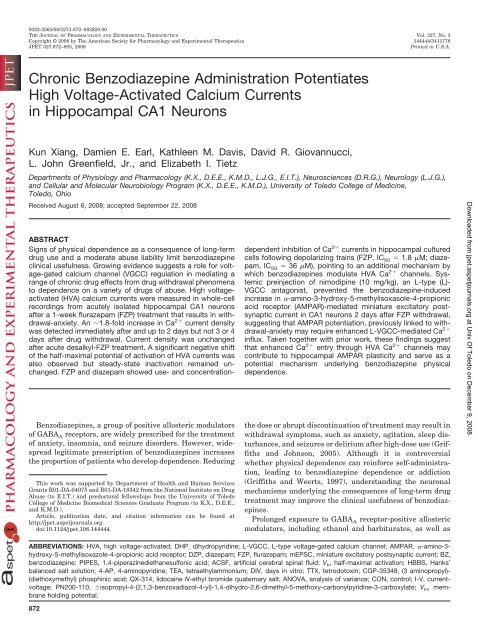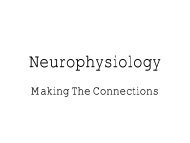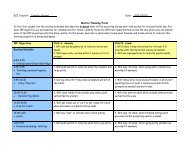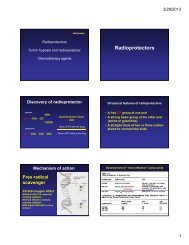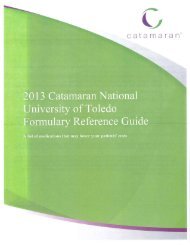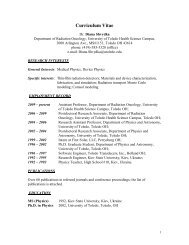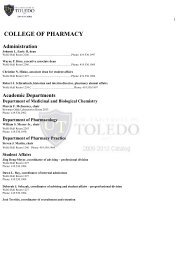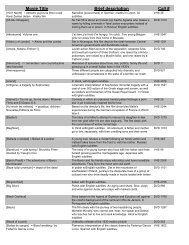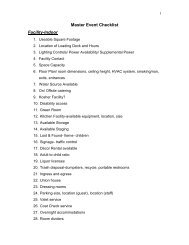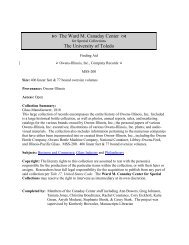Xiang, K., Earl, D.E. Davis, K. Giovannucci, D.R., Greenfield, Jr., L.J. ...
Xiang, K., Earl, D.E. Davis, K. Giovannucci, D.R., Greenfield, Jr., L.J. ...
Xiang, K., Earl, D.E. Davis, K. Giovannucci, D.R., Greenfield, Jr., L.J. ...
You also want an ePaper? Increase the reach of your titles
YUMPU automatically turns print PDFs into web optimized ePapers that Google loves.
0022-3565/08/3273-872–883$20.00<br />
THE JOURNAL OF PHARMACOLOGY AND EXPERIMENTAL THERAPEUTICS Vol. 327, No. 3<br />
Copyright © 2008 by The American Society for Pharmacology and Experimental Therapeutics 144444/3411778<br />
JPET 327:872–883, 2008 Printed in U.S.A.<br />
Chronic Benzodiazepine Administration Potentiates<br />
High Voltage-Activated Calcium Currents<br />
in Hippocampal CA1 Neurons<br />
Kun <strong>Xiang</strong>, Damien E. <strong>Earl</strong>, Kathleen M. <strong>Davis</strong>, David R. <strong>Giovannucci</strong>,<br />
L. John <strong>Greenfield</strong>, <strong>Jr</strong>., and Elizabeth I. Tietz<br />
Departments of Physiology and Pharmacology (K.X., D.E.E., K.M.D., L.J.G., E.I.T.), Neurosciences (D.R.G.), Neurology (L.J.G.),<br />
and Cellular and Molecular Neurobiology Program (K.X., D.E.E., K.M.D.), University of Toledo College of Medicine,<br />
Toledo, Ohio<br />
Received August 6, 2008; accepted September 22, 2008<br />
ABSTRACT<br />
Signs of physical dependence as a consequence of long-term<br />
drug use and a moderate abuse liability limit benzodiazepine<br />
clinical usefulness. Growing evidence suggests a role for voltage-gated<br />
calcium channel (VGCC) regulation in mediating a<br />
range of chronic drug effects from drug withdrawal phenomena<br />
to dependence on a variety of drugs of abuse. High voltageactivated<br />
(HVA) calcium currents were measured in whole-cell<br />
recordings from acutely isolated hippocampal CA1 neurons<br />
after a 1-week flurazepam (FZP) treatment that results in withdrawal-anxiety.<br />
An 1.8-fold increase in Ca 2 current density<br />
was detected immediately after and up to 2 days but not 3 or 4<br />
days after drug withdrawal. Current density was unchanged<br />
after acute desalkyl-FZP treatment. A significant negative shift<br />
of the half-maximal potential of activation of HVA currents was<br />
also observed but steady-state inactivation remained unchanged.<br />
FZP and diazepam showed use- and concentration-<br />
Benzodiazepines, a group of positive allosteric modulators<br />
of GABA A receptors, are widely prescribed for the treatment<br />
of anxiety, insomnia, and seizure disorders. However, widespread<br />
legitimate prescription of benzodiazepines increases<br />
the proportion of patients who develop dependence. Reducing<br />
This work was supported by Department of Health and Human Services<br />
Grants R01-DA-04075 and R01-DA-18342 from the National Institute on Drug<br />
Abuse (to E.I.T.) and predoctoral fellowships from the University of Toledo<br />
College of Medicine Biomedical Sciences Graduate Program (to K.X., D.E.E.,<br />
and K.M.D.).<br />
Article, publication date, and citation information can be found at<br />
http://jpet.aspetjournals.org.<br />
doi:10.1124/jpet.108.144444.<br />
dependent inhibition of Ca 2 currents in hippocampal cultured<br />
cells following depolarizing trains (FZP, IC 50 1.8 M; diazepam,<br />
IC 50 36 M), pointing to an additional mechanism by<br />
which benzodiazepines modulate HVA Ca 2 channels. Systemic<br />
preinjection of nimodipine (10 mg/kg), an L-type (L)-<br />
VGCC antagonist, prevented the benzodiazepine-induced<br />
increase in -amino-3-hydroxy-5-methylisoxasole-4-propionic<br />
acid receptor (AMPAR)-mediated miniature excitatory postsynaptic<br />
current in CA1 neurons 2 days after FZP withdrawal,<br />
suggesting that AMPAR potentiation, previously linked to withdrawal-anxiety<br />
may require enhanced L-VGCC-mediated Ca 2<br />
influx. Taken together with prior work, these findings suggest<br />
that enhanced Ca 2 entry through HVA Ca 2 channels may<br />
contribute to hippocampal AMPAR plasticity and serve as a<br />
potential mechanism underlying benzodiazepine physical<br />
dependence.<br />
the dose or abrupt discontinuation of treatment may result in<br />
withdrawal symptoms, such as anxiety, agitation, sleep disturbances,<br />
and seizures or delirium after high-dose use (Griffiths<br />
and Johnson, 2005). Although it is controversial<br />
whether physical dependence can reinforce self-administration,<br />
leading to benzodiazepine dependence or addiction<br />
(Griffiths and Weerts, 1997), understanding the neuronal<br />
mechanisms underlying the consequences of long-term drug<br />
treatment may improve the clinical usefulness of benzodiazepines.<br />
Prolonged exposure to GABA A receptor-positive allosteric<br />
modulators, including ethanol and barbiturates, as well as<br />
ABBREVIATIONS: HVA, high voltage-activated; DHP, dihydropyridine; L-VGCC, L-type voltage-gated calcium channel; AMPAR, -amino-3hydroxy-5-methylisoxazole-4-propionic<br />
acid receptor; DZP, diazepam; FZP, flurazepam; mEPSC, miniature excitatory postsynaptic current; BZ,<br />
benzodiazepine; PIPES, 1,4-piperazinediethanesulfonic acid; ACSF, artificial cerebral spinal fluid; V h, half-maximal activation; HBBS, Hanks’<br />
balanced salt solution; 4-AP, 4-aminopyridine; TEA, tetraethylammonium; DIV, days in vitro; TTX, tetrodotoxin; CGP-35348, (3 aminopropyl)-<br />
(diethoxymethyl) phosphinic acid; QX-314, lidocaine N-ethyl bromide quaternary salt; ANOVA, analysis of variance; CON, control; I-V, currentvoltage;<br />
PN200-110, isopropyl-4-(2,1,3-benzoxadiazol-4-yl)-1,4-dihydro-2,6-dimethyl-5-methoxy-carbonylpyridine-3-carboxylate; V H, membrane<br />
holding potential.<br />
872<br />
Downloaded from<br />
jpet.aspetjournals.org at Univ Of Toledo on December 9, 2008
other drugs of abuse has been reported to enhance high<br />
voltage-activated calcium channels (HVAs), predominantly<br />
L-type voltage-gated calcium channel (L-VGCC) expression<br />
(Walter and Messing, 1999; Katsura et al., 2002, 2005, 2007;<br />
Rajadhyaksha and Kosofsky, 2005; Shibasaki et al., 2007).<br />
Benzodiazepine administration can similarly regulate VGCC<br />
expression. For example, [ 3 H]diltiazem binding sites were<br />
up-regulated in mouse cortical cultures, concomitant with an<br />
increase in L-VGCC subunit expression after 3-day exposure<br />
of mouse cortical cultures to 1,4- or 1,5-benzodiazepines and<br />
in diazepam (DZP)-treated mice exhibiting withdrawal signs<br />
(Katsura et al., 2007). Moreover, benzodiazepines can directly<br />
inhibit L-VGCC-mediated Ca 2 influx and HVA currents<br />
(Taft and DeLorenzo, 1984; Gershon, 1992; Reuveny et<br />
al., 1993; Ishizawa et al., 1997), raising the possibility that<br />
chronic benzodiazepine administration in vivo can modulate<br />
VGCC function.<br />
VGCCs have been implicated in mediating synaptic plasticity<br />
associated with dependence on a wide range of central<br />
nervous system stimulants and depressants (Whittington<br />
and Little, 1993; Pourmotabbed et al., 1998; Rabbani and<br />
Little, 1999; Katsura et al., 2002, 2005, 2007; Watson and<br />
Little, 2002; Rajadhyaksha and Kosofsky, 2005). Specifically,<br />
previous studies from our laboratory have demonstrated<br />
an enhancement of -amino-3-hydroxy-5-methylisoxasole-4propionic<br />
acid receptor (AMPAR) synaptic currents in hippocampal<br />
CA1 neurons (Van Sickle and Tietz, 2002; Song<br />
et al., 2007), which was associated with anxiety-like behavior<br />
in benzodiazepine-withdrawn rats (Van Sickle et al., 2004;<br />
<strong>Xiang</strong> and Tietz, 2007). Notably, acute systemic injection of<br />
the L-VGCC antagonist nimodipine, before AMPAR current<br />
enhancement, prevented both the augmentation of AMPAR<br />
currents in hippocampal CA1 neuron and anxiety-like behavior<br />
in benzodiazepine-withdrawn rats (<strong>Xiang</strong> and Tietz,<br />
2007). These findings are consistent with other studies showing<br />
that administration of L-VGCC antagonists can interrupt<br />
withdrawal symptoms following benzodiazepine treatment<br />
(Gupta et al., 1996; El Ganouni et al., 2004; Cui et al., 2007),<br />
pointing to a role for regulation of L-VGCCs in mediating<br />
benzodiazepine dependence. However, little is known about<br />
the possible underlying mechanisms by which such adaptations<br />
may occur.<br />
To investigate the means by which L-VGCCs could mediate<br />
benzodiazepine withdrawal phenomena, the properties of<br />
HVA Ca 2 currents were examined using whole-cell voltageclamp<br />
techniques in hippocampal CA1 pyramidal neurons<br />
isolated from rats orally administered the water-soluble benzodiazepine<br />
flurazepam (FZP) for 1 week. The temporal pattern<br />
of changes in Ca 2 current density and activation kinetics<br />
was evaluated immediately and up to 4 days after drug<br />
withdrawal and in neurons from rats acutely administered<br />
desalkyl-FZP. In addition, the direct concentration- and usedependent<br />
effect of the benzodiazepines to affect dihydropyridine<br />
(DHP) binding and HVA Ca 2 current density was<br />
evaluated in primary hippocampal culture. Finally, the<br />
ability of nimodipine preinjection to prevent the persistent<br />
enhancement AMPAR-mediated mEPSC amplitude was examined,<br />
to determine whether L-VGCCs not only initiate<br />
AMPAR current potentiation (<strong>Xiang</strong> and Tietz, 2007) but also<br />
play an additional role in maintaining current enhancement.<br />
Collectively, the findings suggest that chronic FZP administration<br />
transiently enhances L-VGCC function, which may<br />
Benzodiazepine Effect on Voltage-Gated Calcium Currents 873<br />
serve to regulate intracellular calcium signaling and ultimately<br />
contribute to AMPAR plasticity and benzodiazepine<br />
withdrawal-anxiety. Modulation of VGCC function may relate<br />
to a direct interaction between benzodiazepines and<br />
HVA channels, in addition to the well known effects of the<br />
benzodiazepines at the GABA A receptor.<br />
Materials and Methods<br />
Protocols<br />
Experimental protocols involving the use of vertebrate animals<br />
were approved by the University of Toledo College of Medicine (formerly<br />
the Medical University of Ohio, Toledo, OH) Institutional<br />
Animal Care and Use Committee and conformed to National Institutes<br />
of Health guidelines.<br />
In Vivo Drug Treatments<br />
Chronic Flurazepam Administration. Oral FZP treatment of<br />
rats was as described previously (Van Sickle et al., 2004). In short,<br />
male Sprague-Dawley rats (initial age, postnatal day 22–25; Harlan,<br />
Indianapolis, IN) were offered only saccharin solution for a 2- to<br />
4-day adaptation period. FZP dihydrochloride, pH 5.8, was then<br />
offered in 0.02% saccharin solution for 1 week as their only source of<br />
drinking water. The concentration of FZP was adjusted daily according<br />
to each rat’s body weight and fluid consumption (100 mg/kg 3<br />
days followed by 150 mg/kg 4 days). Only rats that consumed a<br />
criterion dose of an average 120 mg/kg/day were accepted for study.<br />
At the end of drug administration, saccharin water was again provided<br />
for 0, 2, 3, or 4 days before hippocampal slice preparation on<br />
postnatal day 35 to 40 rats. Pair-handled, matched control rats<br />
receive saccharin water for the same length of time. Experimenters<br />
were blinded to rat treatment groups until the completion of the data<br />
analysis.<br />
After this chronic FZP treatment, brain levels of residual FZP and<br />
its metabolites (1.2 M) when expressed in DZP equivalents (0.6 M)<br />
are similar to that of other common chronic benzodiazepine treatments<br />
(Gallager et al., 1985; Xie and Tietz, 1992). Unlike in humans,<br />
brain levels of residual FZP and its metabolites decline rapidly over<br />
the first 24 h after drug removal and are no longer detectable in<br />
hippocampus in 2-day FZP-withdrawn rats (Xie and Tietz, 1992).<br />
Acute Desalkyl-FZP Administration. To determine whether<br />
changes in hippocampal slices are specific to chronic BZ treatment,<br />
an acute dose of the primary active metabolite of FZP, desalkyl-FZP,<br />
was given to another group of rats. As described previously (Van<br />
Sickle and Tietz, 2002), desalkyl-FZP (2.5 mg/kg p.o.) was administered<br />
by gavage in an emulsion of peanut oil, water, and acacia<br />
(4:2:1). Rats were euthanized 30 min later for hippocampal slice<br />
preparation. Control rats received an equivalent volume of emulsion<br />
vehicle. The single dose of desalkyl-FZP was demonstrated previously<br />
by radioreceptor assay to result in levels of benzodiazepine<br />
activity similar to that found in rat hippocampus after 1-week FZP<br />
treatment, without a concomitant effect on GABAA receptor-mediated<br />
inhibition (Xie and Tietz, 1992).<br />
Systemic L-VGCC Antagonist Injection. Control and FZPwithdrawn<br />
rats were given a single intraperitoneal injection of nimodipine<br />
(10 mg/kg i.p.), an L-VGCC antagonist, or 2 ml/kg vehicle<br />
(0.5% Tween 80) 1 day after ending 1-week FZP treatment and 24 h<br />
before hippocampal slice preparation from 2-day FZP-withdrawn<br />
rats.<br />
Tissue Preparations<br />
Acutely Isolated Hippocampal CA1 Pyramidal Neurons.<br />
CA1 pyramidal neurons were acutely isolated using modifications of<br />
methods described previously (Van Sickle et al., 2002). Briefly, hippocampal<br />
slices, 400 m were prepared on a Vibratome sectioning<br />
system (Ted Pella, Inc., Reading, CA) in ice-cold, pregassed (95% O2, 5% CO2) buffer containing 120 mM NaCl, 2.5 mM KCl, 0.1 mM<br />
Downloaded from<br />
jpet.aspetjournals.org at Univ Of Toledo on December 9, 2008
874 <strong>Xiang</strong> et al.<br />
CaCl 2, 4 mM MgCl 2, 20 mM PIPES, and 25 mM D-glucose, pH 7.4.<br />
Slices were maintained at room temperature for 2 h and then incubated<br />
for 40 min at 37°C in the PIPES buffer containing 120 mM<br />
NaCl, 2.5 mM KCl, 1.5 mM CaCl 2, 4 mM MgCl 2, 20 mM PIPES, and<br />
25 mM D-glucose, pH 7.4, containing protease XIV (Sigma-Aldrich,<br />
St. Louis, MO), 1.4 units/ml. Slices were then washed for 5 min in 20<br />
ml of bovine serum albumin (1 mg/ml) solution followed by a 10-min<br />
wash in PIPES buffer. The CA1 region was microdissected on ice,<br />
notched, and triturated using a 25-gauge Pasteur pipette and then<br />
30-gauge Pasteur pipette in 100 l of ice-cold PIPES. The cell suspension<br />
(50 l) was plated on each of two polylysine-coated (2 mg/ml,<br />
poly-D-lysine; 2 mg/ml, poly-DL-lysine) culture dishes for 15 to 45 min<br />
before recording.<br />
Hippocampal Slice Preparation. For mEPSC recording, transverse<br />
dorsal hippocampal slices (400 m) were prepared as described<br />
above, but in ice-cold, pregassed (95% O 2,5%CO 2) artificial cerebrospinal<br />
fluid (ACSF) containing 120 mM NaCl, 2.5 mM KCl, 0.5 mM<br />
CaCl 2, 7.0 mM MgSO 4, 1.2 mM NaH 2PO 4, 2 mM NaHCO 3,20mM<br />
D-glucose, and 1.3 mM ascorbate, pH 7.4. Slices were maintained at<br />
room temperature (22°C) for 15 min in gassed, low-calcium, highmagnesium<br />
ACSF and then transferred to normal ACSF containing<br />
119 mM NaCl, 2.5 mM KCl, 1.8 mM CaCl 2, 1.3 mM MgSO 4 1.25 mM<br />
NaH 2PO 4, 26 mM NaHCO 3, and 10 mM D-glucose, pH 7.4. Slices<br />
were maintained at 22°C for 1 h. During recording, slices were<br />
perfused at 2.5 ml/min with gassed ACSF at 22°C.<br />
Primary Hippocampal Neuron Cell Cultures. To evaluate the<br />
concentration-dependent and use-dependent effects of the benzodiazepines<br />
on HVA channel function, FZP and DZP effects on Ca 2<br />
currents were evaluated in hippocampal cultured cells. Briefly, hippocampal<br />
tissue was dissected from embryonic day 18 Sprague-<br />
Dawley rats, collected in 1 Hanks’ balanced salt solution (HBSS)<br />
(Invitrogen, Carlsbad, CA), and incubated for 20 min in 0.25% trypsin-EDTA<br />
(Invitrogen) at 37°C with 5% CO 2. The trypsin solution<br />
was aspirated, and tissue was washed three times with HBSS. HBSS<br />
was replaced by medium containing modified Eagle’s medium (Cellgro)<br />
with L-glutamine, 10% fetal bovine serum (Invitrogen), 6 mg/ml<br />
glucose, and 1 penicillin/streptomycin (Invitrogen), and the tissue<br />
was triturated using flame-polished Pasteur pipettes. Dissociated<br />
cells were plated onto coverslips coated with 0.2 mg/ml poly-DLornithine<br />
(Sigma-Aldrich) at a density of 3 10 6 cells/ml medium.<br />
The mixed glial and neuronal cultures were maintained in vitro for<br />
10 to 14 days, and electrophysiological recordings were performed on<br />
neurons with pyramidal cell morphology.<br />
Electrophysiology<br />
HVA Ca 2 Current Recording. HVA currents were recorded<br />
under whole-cell voltage-clamp conditions at room temperature using<br />
patch pipettes of 3- to 6-M resistance. Neurons with a bright<br />
and smooth appearance and pyramidal shape, with at least one<br />
moderate-to-large apical dendrite, typically with numerous additional<br />
basal and apical dendrites (Song et al., 2007), were selected for<br />
recording. Presumptive interneurons, i.e., very large pyramidalshaped<br />
neurons or bipolar neurons, as well as elliptical-shaped neurons<br />
were excluded. The external solution contained 110 mM NaCl,<br />
10 mM HEPES, 25 mM TEA chloride, 5.4 mM KCl, 5 mM CaCl2, 5 mM 4-AP, 1 mM MgCl2,25mMD-glucose, and 1 M tetrodotoxin<br />
(TTX), pH 7.4. The electrode solution contained 110 mM CsF, 25 mM<br />
TEA chloride, 20 mM phosphocreatine, 50 units/ml phosphocreatine<br />
kinase, 10 mM EGTA, 10 mM HEPES, 5 mM NaCl, 2 mM MgCl2, 0.5<br />
mM CaCl2, 0.5 mM BaCl2, 2 mM MgATP, and 0.1 mM NaGTP, pH<br />
7.3. Currents were recorded with an Axoclamp 200B amplifier (Molecular<br />
Devices, Sunnyvale, CA) using a Digidata 1200B AD/DA<br />
converter and pClamp 9.2 acquisition software (Molecular Devices).<br />
After establishing the whole-cell configuration, cells were allowed to<br />
stabilize for 10 min before current recording protocols were initiated.<br />
Neurons were voltage-clamped at a membrane holding potential<br />
(VH) 65 mV. Peak HVA calcium currents (picoampere) were<br />
activated with a protocol modified from Sochivko et al. (2003) using<br />
200-ms voltage steps to voltage levels between 70 and 40 mV in<br />
10-mV increments, preceded by a 3-s hyperpolarization prepulse to<br />
80 mV. The steady-state inactivation of Ca 2 currents was evaluated<br />
with a 200-ms test pulse to 10 mV, preceded by a 1500-ms<br />
conditioning prepulse ranging from 80 to 10 mV, in 10-mV increments.<br />
Currents were corrected for linear, nonspecific leak currents,<br />
and capacitive transients. Series resistance was compensated (80–<br />
90%). Current density was calculated as a function of cell membrane<br />
capacitance (picofarads), an estimate of cell size.<br />
Ca 2 Current Analysis. Whole-cell calcium currents were analyzed<br />
off-line using Clampfit 9.2 software (Molecular Devices). Current<br />
density (picoampere per picofarad) was defined as peak current<br />
amplitude divided by membrane capacitance and was plotted as a<br />
function of membrane potential (millivolts). Activation curves were<br />
constructed using individual conductance values for each cell using<br />
the equation G I/(V t V r), where V t is the test voltage, V r is the cell<br />
reversal potential, and I is the measured current (Sochivko et al.,<br />
2003). The current was then normalized to G max, the maximal conductance.<br />
Inactivation curves were constructed by normalizing peak<br />
current amplitude to the maximal amplitude. The data points for the<br />
conductance, G were fitted with a Boltzmann equation: G/G max <br />
1/{1 exp[(V V h)/k]}, where G max is the maximal Ca 2 conductance,<br />
V H is the potential where G was the half-maximal G max and k<br />
is a factor proportional to the slope at V h. Data points were normalized<br />
to the maximal conductance, averaged, and plotted. Inactivation<br />
curves were constructed by normalizing the current values to the<br />
largest value then fitted with the Boltzmann equation I(V)/I max <br />
1/{1 exp[(V V h)/k]}.<br />
Use- and Concentration-Dependent Inhibition of Ca 2 Currents.<br />
The use- and concentration-dependent effect of FZP and DZP<br />
on whole-cell HVA currents was assessed in 10 to 14 days in vitro<br />
(DIV) hippocampal cultured cells. A protocol modified from Reuveny<br />
et al., (1993) was used to deliver test pulses before and following a<br />
series of depolarizing trains delivered at several frequencies. After a<br />
200-ms baseline test pulse (10 mV from V H at 80 mV), trains of<br />
eight equivalent depolarizing pulses were delivered. Trains were<br />
applied at frequencies of 1, 2, 3, or 4 Hz followed within 10 ms by<br />
another test pulse. A recovery test pulse, without prior train stimulation<br />
was given at the end of the recording to exclude run-down of<br />
Ca 2 channel function or seal degradation. The intertrain interval<br />
was 1 min to allow complete recovery from Ca 2 -dependent inactivation<br />
between trains. To study FZP effects on HVA currents, the<br />
current density associated with each test pulse was evaluated in a<br />
train or no train condition, after 5-min preincubation with 1 M FZP<br />
or vehicle in the external recording solution. Ca 2 current density<br />
was normalized and expressed as the percentage of the current<br />
evoked by the baseline test pulse. To study concentration-dependent<br />
inhibition, benzodiazepine (0.1–100 M) effects to inhibit Ca 2 current<br />
test pulses were evaluated after 5-min preincubation in the<br />
train condition. To determine whether benzodiazepines inhibit Ca 2<br />
current directly or through their action on GABA A receptors, the<br />
effect of the benzodiazepine antagonist flumazenil (1 M) on HVA<br />
Ca 2 current was also studied in the presence or absence of DZP. The<br />
Ca 2 current density was normalized and expressed as a percentage<br />
of current evoked in the presence of vehicle.<br />
AMPAR-Mediated mEPSC Recording. AMPAR-mediated mEP-<br />
SCs were recorded from CA1 neurons in ACSF plus 1 M TTX, 50 M<br />
picrotoxin, and 25 M CGP-35348 using whole-cell voltage-clamp techniques<br />
(<strong>Xiang</strong> and Tietz, 2007). Patch pipettes (3–6 M) were filled<br />
with internal solution containing 132.5 mM Cs methanesulfonate, 17.5<br />
mM CsCl, 10 mM HEPES, 0.2 mM EGTA, 8 mM NaCl, 2 mM Mg-ATP,<br />
0.3 mM Na-GTP, and 2 mM QX-314, pH 7.2, adjusted with CsOH.<br />
Resting membrane potential was measured immediately upon cell<br />
break-in. Neurons were voltage-clamped (V H 80 mV) in continuous<br />
mode (continuous single electrode voltage clamp) using an Axoclamp 2A<br />
amplifier (Molecular Devices) to isolate AMPAR-receptor-mediated<br />
from N-methyl-D-aspartate receptor-mediated excitatory postsynaptic<br />
currents. mEPSC activity was recorded for 5 min and analyzed with<br />
Downloaded from<br />
jpet.aspetjournals.org at Univ Of Toledo on December 9, 2008
MiniAnalysis software (Synaptosoft Inc., Leonia, NJ) as described previously<br />
(<strong>Xiang</strong> and Tietz, 2007).<br />
Displacement of [ 3 H]Dihydropyridine Binding<br />
The effect of benzodiazepines to inhibit DHP binding to L-VGCCs<br />
in homogenates of rat brain membranes was evaluated. Whole-brain<br />
homogenates (minus cerebellum and brain stem) were prepared as<br />
described previously (Xie and Tietz, 1992), except that the P2 pellet<br />
was initially incubated for 30 min at 37°C to remove ascorbic acid,<br />
and then tissues were freeze-thawed overnight and resuspended to a<br />
final concentration of 0.5 mg/ml as determined by bicinchoninic acid<br />
assay (Pierce Chemical, Rockford, IL). The reaction, initiated by<br />
addition of 320 l of homogenate, was incubated for 90 min in a<br />
dimly lit room with 40 l of 2 nM of the high-affinity DHP antagonist,<br />
[ 3 H]PN200-110 in the presence or absence of increasing concentrations<br />
of nimodipine (10 pM to 1 mM) or FZP or DZP (1 nM to 1<br />
mM) in 50 mM Tris-HCl buffer, pH 7.7, at room temperature. Nonspecific<br />
binding was determined in the presence of 10 M nitrendipine.<br />
The binding reaction was terminated by rapid vacuum filtration<br />
on number 32 glass fiber filters (Whatman Schleicher and Schuell,<br />
Keene, NH), followed by 3 5 ml of ice-cold buffer washes. Filters<br />
were equilibrated overnight and counted 5 min in ScintiSafe 30%<br />
(Thermo Fisher Scientific, Waltham, MA).<br />
Statistical Comparisons. Data are reported as mean S.E.M.<br />
Individual comparisons of Ca 2 current characteristics between experimental<br />
groups at each withdrawal period were by two-tailed<br />
unpaired Student’s t test with Bonferroni’s correction (/n) for multiple<br />
comparisons (n) (Table 1). Peak current density (VH 0 mV)<br />
across groups was analyzed by ANOVA followed by Bonferroni’s<br />
multiple comparison test (Fig. 2). Comparisons of mEPSC characteristics<br />
were by ANOVA (Fig. 7; Table 2) followed by the method of<br />
Scheffé. Asterisks denote significant differences between control and<br />
FZP-treated groups (0.05). For both whole-cell recordings of HVA<br />
Ca 2 currents and benzodiazepine displacement of [ 3 H]PN200-110,<br />
binding curves were fit by nonlinear regression, where I Imin <br />
(Imax Imin)/(1 10ˆ((log IC50 log[drug]) Hill slope)).<br />
Drug Solutions. Drugs used for superfusion during whole-cell<br />
recording were dissolved at 100 times their final concentration and<br />
added to the perfusate with a syringe pump (Razel; WPI, Sarasota,<br />
FL) at a rate of 25 to 75 l/min to achieve their final concentration.<br />
Nimodipine was dissolved in 0.5% Tween 80 solution and kept in a<br />
light-tight vial. All other drugs were dissolved in distilled H2O. QX-314, picrotoxin, TEA chloride, 4-AP, and nimodipine were all<br />
from Sigma-Aldrich. TTX was obtained from Alamone Laboratories<br />
(Jerusalem, Israel). CGP-35348 was purchased from Tocris Bioscience<br />
(Ellisville, MO). FZP dihydrochloride was supplied by the<br />
National Institutes of Drug Abuse Supply Program (National Institutes<br />
of Drug Abuse, Bethesda, MD).<br />
Results<br />
HVA Ca 2 Currents in Acutely Isolated Hippocampal<br />
CA1 Pyramidal Neurons. To study Ca 2 channel function<br />
associated with FZP administration, HVA Ca 2 currents<br />
were recorded in acutely isolated hippocampal CA1 pyramidal<br />
neurons from rats after different lengths of FZP (or FZP<br />
metabolite) treatment and withdrawal. To isolate calcium<br />
currents, potassium currents were blocked with TEA, 4-AP,<br />
and Cs and sodium currents with TTX. Elicited currents<br />
were pharmacologically confirmed as predominantly L-type<br />
Ca 2 currents via inhibition with nimodipine (10 M), a<br />
selective L-VGCC antagonist (Fig. 1B). The nimodipine-resistant<br />
current is likely attributable to P/Q, N, and predominantly<br />
R-type HVA currents (Catterall, 2000). Figure 1, C<br />
and D, shows representative Ca 2 current traces elicited in TABLE 1<br />
Benzodiazepine Effect on Voltage-Gated Calcium Currents 875<br />
Effects of chronic benzdodiazepine administration and withdrawal on CA1 pyramidal neuron HVA Ca 2 currents<br />
Values are mean S.E.M. Comparisons between FZP-withdrawal groups and their matched controls were analyzed by a two-tailed unpaired Student’s t test with Bonferroni’s correction ( 0.05/n).<br />
Acute Desalkyl-FZP Treatment Withdrawal from 1-Week FZP Treatment<br />
0 Day 0 Day 2 Day 3 Day 4 Day<br />
Measure<br />
CON (n 10) FZP (n 10) CON (n 10) FZP (n 12) CON (n 25) FZP (n 25) CON (n 19) FZP (n 18) CON (n 7) FZP (n 8)<br />
Capacitance (pF) 18.6 1.6 19.3 1.7 19.7 1.0 19.8 1.0 19.7 0.9 19.0 0.7 20.0 1.0 20.1 0.8 19.3 1.5 18.7 1.7<br />
Current density (pA/pF) 18.7 1.4 17.7 1.1 21.4 2.4 35.4 4.6* 19.9 2.5 36.1 3.7* 20.5 3.3 25.9 3.4 21.8 3.3 20.9 4.1<br />
Activation Vh (mV) 6.0 2.5 4.3 3.5 5.8 2.0 11.7 1.2* 4.2 1.5 13.6 1.7* 5.8 1.8 8.9 2.4 4.0 1.2 4.8 1.7<br />
Activation slope (dV) 16.7 1.0 16.5 0.9 17.1 1.4 16.4 0.8 16.5 0.9 16.1 1.0 15.9 1.2 16.4 1.7 16.6 1.1 16.5 1.0<br />
Inactivation Vh (mV) 30.5 1.5 31.0 0.9 31.1 2.0 30.8 1.2 29.4 1.3 31.2 1.0 N.T. N.T. N.T. N.T.<br />
Inactivation slope (dV) 11.2 0.6 10.9 0.8 10.9 0.2 11.4 0.3 11.8 0.3 10.2 0.5 N.T. N.T. N.T. N.T.<br />
N.T., not tested.<br />
* Significant difference, p 0.05/n.<br />
Downloaded from<br />
jpet.aspetjournals.org at Univ Of Toledo on December 9, 2008
876 <strong>Xiang</strong> et al.<br />
TABLE 2<br />
Effects of systemic nimodipine on CA1 pyramidal neuron mEPSC characteristics<br />
Values are means S.E.M. Groups were compared by ANOVA followed by post hoc comparisons by the method of Scheffé; p values represent post hoc comparisons between<br />
the designated injection groups.<br />
Group RMP<br />
neurons isolated from a control (CON) and a 2-day FZPwithdrawn<br />
rat (FZP), respectively.<br />
Temporal Regulation of HVA Ca 2 Currents. The<br />
temporal pattern of changes in HVA channel function in CA1<br />
neurons following acute treatment and after withdrawal<br />
from 1-week FZP treatment is summarized in Fig. 2 and<br />
Table 1. To demonstrate that enhanced HVA current density<br />
associated with FZP treatment was specific to protracted<br />
benzodiazepine exposure, an acute dose of the primary FZPactive<br />
metabolite, desalkyl-FZP (2.5 mg/kg p.o.), was given to<br />
one group of rats. This dose results in comparable benzodiazepine<br />
levels to that after 1-week FZP treatment (Van<br />
Sickle et al., 2004). Control rats received only the emulsion<br />
vehicle. There were no significant differences in Ca 2 current<br />
density in neurons from acute desalkyl-FZP-treated rats (n <br />
10) in comparison with controls (n 10) (Fig. 2A). The<br />
current-voltage (I-V) curves generated in neurons from<br />
acutely treated rats and their controls were superimposable<br />
(Fig. 2A), similar to that illustrated after 4-day withdrawal<br />
in Fig. 2E.<br />
The withdrawal periods examined after 1-week FZP administration<br />
precede and extend beyond the window of enhanced<br />
AMPAR glutamatergic strength associated with anx-<br />
mEPSC Characteristics<br />
Frequency Rise Time Amplitude <br />
mV Hz ms pA ms<br />
CON-VEH (n 8) 61.0 2.1 0.26 0.04 2.6 0.5 8.5 1.4 16.7 2.8<br />
p 0.48 p 0.70<br />
vs. CON-NIM vs. CON-NIM<br />
FZP-VEH (n 8) 61.0 1.8 0.30 0.07 2.8 0.3 11.1 0.9 15.6 1.8<br />
p 0.001* p 0.90<br />
vs. CON-VEH vs. CON-VEH<br />
p 0.007* p 0.76<br />
vs. FZP-NIM vs. FZP-NIM<br />
CON-NIM (n 7) 61.4 1.7 0.27 0.06 2.5 0.5 9.3 1.5 16.3 1.5<br />
FZP-NIM (n 7) 60.0 1.9 0.27 0.05 2.5 0.5 9.0 1.6 17.1 2.1<br />
p 0.99 p 0.54<br />
vs. CON-NIM vs. CON-NIM<br />
ANOVA p 0.05 p 0.05 p 0.05 p 0.001* p 0.05<br />
CON, control; NIM, intraperitoneal injection of nimodipine; RMP, resting membrane potential; VEH, intraperitoneal injection of vehicle. * p 0.05.<br />
Fig. 1. Representative HVA Ca 2 current<br />
traces. Whole-cell currents were elicited from<br />
acutely isolated CA1 neurons. A, activation<br />
pulse protocol: 200-ms depolarizing voltage<br />
steps ranging from 70 to 40 mV in 10-mV<br />
increments were preceded by a 3-s prepulse<br />
to 80 mV. Membrane holding potential (V H)<br />
was 65 mV. B, example traces of peak Ca 2<br />
currents evoked in a FZP withdrawn CA1<br />
neuron at 10 mV in the presence and absence<br />
of 10 M nimodipine, a selective L-type<br />
VGCC antagonist. C and D, representative<br />
calcium current traces elicited in neurons<br />
isolated from a CON and a 2-day FZP-withdrawn<br />
rat.<br />
iety-like behavior (Van Sickle et al., 2004; <strong>Xiang</strong> and Tietz,<br />
2007). I-V plots and peak current density in control neurons<br />
were similar to those described previously in dissociated CA1<br />
neurons (Gorter et al., 2002) and were similar across all<br />
control groups (ANOVA, F 2.1, df 4, p 0.09) (Fig. 2,<br />
A–E). There was a significant increase in Ca 2 current density<br />
in CA1 neurons isolated from rats immediately after<br />
(0-day) withdrawal from 1-week FZP treatment (n 12, p <br />
0.05; ANOVA, F 3.8, df 9, p 0.0002) compared with<br />
that from matched control rats (n 10) (Fig. 2B). The increase<br />
in Ca 2 current density was sustained up to 2 days.<br />
That is, an equivalent increase in current density was found<br />
in neurons from 2-day FZP-withdrawn rats (n 25; p <br />
0.01) in comparison with control neurons (n 25) (Fig. 2C).<br />
Ca 2 current density was not significantly increased when<br />
examined in neurons from 3-day FZP-withdrawn rats (n <br />
18) (Fig. 2D) compared with matched control rats (n 19;<br />
p 0.05). After 4-day withdrawal, when AMPAR function<br />
has returned to baseline (Van Sickle et al., 2004), there were<br />
no significant differences in Ca 2 current density in FZPwithdrawn<br />
rats (n 8; p 0.05) in comparison with controls<br />
(n 7) (Fig. 2E). The time course of changes in peak Ca 2<br />
current density (V H 0 mV) is illustrated in Fig. 2F.<br />
Downloaded from<br />
jpet.aspetjournals.org at Univ Of Toledo on December 9, 2008
Fig. 2. I-V relationship of HVA Ca 2 currents elicited from isolated CA1 neurons. Ca 2 currents were normalized by the membrane capacitance of<br />
individual neurons and are represented as current density (picoampere per picofarad). A, for acute treatment, rats were similarly acclimated and<br />
offered saccharin water for 1 week followed by gavage (2.5 mg/kg p.o.) with the primary FZP metabolite desalkyl-FZP, a dose that results in comparable<br />
BZ levels to that after 1-week FZP treatment. Acute desalkyl-FZP treatment had no effect on Ca 2 current density (open circles, n 10; , p 0.05)<br />
compared with that from matched control rats (closed circles, n 10). B, there was a significant increase in Ca 2 current density in CA1 neurons<br />
isolated from rats immediately after (0-day) withdrawal from 1-week oral FZP-treatment (open circles, n 12; , p 0.05) compared with that from<br />
matched control rats (close circles, n 10). C, a similar increase in Ca 2 current density was found in neurons from 2-day FZP-withdrawn rats<br />
following 1-week FZP-treatment (open circles, n 25; , p 0.05) in comparison with control neurons (closed circles, n 25). D, this increase in Ca 2<br />
current density was no longer significant when examined in neurons from rats treated 1-week with FZP and withdrawn for 3 days (closed circles, n <br />
9; p 0.05) compared with matched control rats (open circles, n 10). E, there were also no significant differences in Ca 2 current density in neurons<br />
from 4-day FZP-withdrawn rats (closed circles, n 8; p 0.05) in comparison with matched controls (open circles, n 7). F, temporal pattern of<br />
changes in CA1 neuron HVA Ca 2 currents during acute and chronic FZP treatment and withdrawal. Peak Ca 2 current density at V H 0mVis<br />
shown. Acute, 0 days (CON: n 10, closed bars; FZP: n 10, open bars); 0 days (CON: n 10, closed bars; FZP: n 12, open bars); 2 days (CON:<br />
n 25, closed bars; FZP: n 25, open bars); 3 days (CON: n 10, closed bars; FZP: n 9, open bars); or 4 days (CON: n 8, closed bars; FZP: n <br />
7, open bars) after ending 1-week FZP treatment.<br />
Voltage Dependence of Ca 2 Current Activation Is<br />
Altered after FZP Administration. Current amplitudes<br />
elicited by voltage steps from individual neurons were transformed<br />
to yield activation curves. Corresponding to the time<br />
course of the regulation of Ca 2 current density, there was a<br />
significant negative shift of the activation curve obtained<br />
from 0- and 2-day FZP-withdrawn rats compared with neurons<br />
from matched control rats (Fig. 3A). As shown in Table<br />
1, the voltages of half-maximal activation (V h) were significantly<br />
(p 0.008), negatively shifted (Fig. 3B) in neurons<br />
from 0-day FZP-withdrawn rats (n 11) compared with their<br />
matched controls (n 9; p 0.05). This shift was also<br />
observed in neurons from 2-day FZP-withdrawn rats (n 25)<br />
compared with their controls (n 25; p 0.001). There were<br />
Benzodiazepine Effect on Voltage-Gated Calcium Currents 877<br />
no significant differences between the slopes of the activation<br />
curves between any FZP-withdrawn group and their<br />
matched control group (Fig. 3C). There were no differences in<br />
voltage dependence of Ca 2 current activation immediately<br />
after acute desalkyl-FZP, or 3 or 4 days after 1-week FZP<br />
treatment in comparison with controls (Table 1).<br />
Voltage Dependence of Ca 2 Current Steady-State Inactivation<br />
Remained Unchanged. Representative steadystate<br />
inactivation of Ca 2 current traces from CA1 neurons<br />
isolated from a control and a 2-day FZP-withdrawn rat are<br />
shown in Fig. 4, B and C. As shown in Fig. 4D, inactivation<br />
curves were derived by fitting the Boltzman function to Ca 2<br />
currents elicited from individual neurons isolated from control<br />
and FZP-withdrawn rats. There were no significant shifts in the<br />
Downloaded from<br />
jpet.aspetjournals.org at Univ Of Toledo on December 9, 2008
878 <strong>Xiang</strong> et al.<br />
Fig. 3. Voltage dependence of Ca 2 current activation. A, current amplitudes<br />
elicited by voltage steps from individual neurons were transformed<br />
into conductance, normalized to the maximal conductance, and fitted<br />
with Boltzmann’s equation. There was a significant negative shift of the<br />
activation curves derived from FZP-withdrawn rats (0 day, open circles;<br />
2 day, open squares) compared with neurons from matched control rats (0<br />
day, closed circles; 2 day, closed squares). B, voltages of V h were significantly<br />
decreased in neurons from both 0-day FZP-withdrawn rats (open<br />
bars, n 12) compared with controls (solid bars, n 10; , p 0.05), as<br />
well as 2-day FZP-withdrawn rats (open bars, n 25) compared with<br />
their controls (solid bars, n 25; , p 0.05). C, there was no significant<br />
difference between the slopes (dV) of the activation curves between any<br />
FZP-withdrawn group (open bars) and their matched control group (solid<br />
bars, p 0.05).<br />
inactivation curves from either 0- or 2-day FZP-withdrawn neurons<br />
compared with matched control neurons (Fig. 4D). As<br />
shown in Table 1, the voltages of half-maximal inactivation (V h)<br />
were not significantly different from that of FZP-withdrawn<br />
rats compared with their matched control rats (Fig. 4E). There<br />
were also no significant differences in the slopes of the inactivation<br />
curves (dV) between the FZP-withdrawn groups and<br />
their matched control group (Fig. 4F). Because no changes in<br />
inactivation were noted in neurons from rats withdrawn at<br />
earlier time points, inactivation was not tested in neurons derived<br />
from 3- or 4-day FZP-withdrawn rats in which no other<br />
changes in HVA Ca 2 currents were observed. There was no<br />
difference in the voltage dependence of Ca 2 current steadystate<br />
inactivation immediately after acute desalkyl-FZP in comparison<br />
with their matched controls (Table 1).<br />
Low Potency of Benzodiazepines at [ 3 H]Dihydropyridine<br />
Binding Sites. One mechanism by which benzodiazepines<br />
might increase HVA Ca 2 currents is by<br />
directly binding to and inhibiting L-VGCCs, possibly resulting<br />
in compensatory up-regulation of L-VGCC function. Such<br />
binding to L-VGCCs by benzodiazepines might be expected<br />
to disrupt the binding of conventional DHP L-VGCC antagonists.<br />
To evaluate whether FZP might directly inhibit<br />
L-VGCC function by binding to L-VGCCs, we measured, the<br />
ability of benzodiazepines to inhibit binding of the highaffinity<br />
DHP [ 3 H]PN200-110 to rat brain synaptosomes in<br />
a Tris-Cl buffer in the absence of divalent and trivalent<br />
cations (Peterson and Catterall, 1995), which enhance positive<br />
cooperativity. As illustrated in Fig. 5, FZP exhibited<br />
weak concentration-dependent inhibition of specific [ 3 H]-<br />
PN200-110 binding (FZP IC 50 0.4 mM), whereas the prototype<br />
benzodiazepine, DZP, exhibited even lower potency<br />
(IC 50 1.3 mM). A nimodipine displacement curve was used<br />
as a standard for comparison. The benzodiazepines demonstrated<br />
40- to 130-fold lower potency compared with nimodipine<br />
(IC 50 10.2 nM)<br />
Use- and Concentration-Dependent Inhibition of<br />
HVA Ca 2 Current by FZP and DZP. It was next important<br />
to determine whether benzodiazepines can inhibit HVA<br />
Ca 2 currents and whether this occurs at physiologically<br />
relevant concentrations. The use- and concentration-dependent<br />
effects of benzodiazepines on HVA Ca 2 currents were<br />
evaluated in DIV 10 to 14 hippocampal cultured cells. FZP (1<br />
M) had no effect on HVA Ca 2 currents in hippocampal<br />
cultured neurons in which depolarizing pulses were not applied<br />
(VEH, 83.8 3.9%; FZP, 84.9 5.1%; p 0.05) (Fig. 6,<br />
A and B). However, there was a slight run-down of HVA<br />
currents after repeated test pulses in the presence of vehicle.<br />
There were no differences between the benzodiazepines effect<br />
at the frequencies sampled (1–4 Hz); therefore, the inhibition<br />
data were averaged. In neurons in which consecutive depolarizing<br />
trains were applied, there was a significant inhibition<br />
of HVA Ca 2 current density by 1 M FZP compared<br />
with vehicle (VEH, 35.9 5.6%, n 4; FZP, 20.3 2.4%, n <br />
4; p 0.05). The progressive decline in HVA Ca 2 currents<br />
with repeated stimulation probably represents Ca 2 -dependent<br />
inactivation of HVA currents after a train of consecutive<br />
depolarizing pulses as reported by Budde et al. (2002). The<br />
response returned to 94.7% of baseline upon recovery in the<br />
vehicle group and 67.4% in FZP group, suggesting the inhibition<br />
during depolarizing trains was not related the rundown<br />
of Ca 2 channel function or seal degradation (Fig. 6, A<br />
and B).<br />
The concentration-dependent effects of benzodiazepines on<br />
HVA Ca 2 currents were also investigated. FZP and DZP<br />
(0.1–100 M) inhibition of Ca 2 current test pulses following<br />
depolarizing trains were evaluated after 5-min preincubation.<br />
As shown in Fig. 6C, both FZP and DZP (0.1–100 M)<br />
inhibit HVA Ca 2 currents in a concentration-dependent<br />
manner. The IC 50 value for FZP inhibition of Ca 2 current<br />
was 2.0 M (log IC 50 5.7 0.3), with complete block of<br />
Ca 2 currents at 100 M FZP. DZP had a similar, but less<br />
potent, inhibitory effect on HVA Ca 2 currents. The IC 50<br />
value for DZP inhibition was 40 M (log IC 50 4.4 0.2),<br />
and 100 M DZP inhibited only 75% of the Ca 2 current.<br />
The inhibition of Ca 2 currents by the benzodiazepine antagonists<br />
was also similar in magnitude across each frequency<br />
Downloaded from<br />
jpet.aspetjournals.org at Univ Of Toledo on December 9, 2008
Fig. 5. Competitive inhibition of benzodiazepines at [ 3 H]dihydropyridine<br />
binding sites. The benzodiazepines inhibited the binding of the highaffinity<br />
DHP PN200-110 to rat brain membranes with relatively low<br />
potency. In the absence of positive cations, both FZP (closed circles) and<br />
DZP (open circles) exhibited a concentration-dependent inhibition of specific<br />
[ 3 H]PN200-110 binding (FZP IC 50 0.4 mM; DZP 1.3 mM).<br />
Nimodipine (IC 50 10.2 nM; closed squares) displacement is shown for<br />
comparison.<br />
tested. The benzodiazepine antagonist flumazenil (1 M)<br />
abolished 45.2 11.4% of the Ca 2 current, whereas coapplication<br />
of 1 M flumazenil and 1 M DZP inhibited 48.0 <br />
10.7% of the Ca 2 current, confirming that this inhibition is<br />
not mediated by action at the GABA A receptor benzodiazepine<br />
site.<br />
Systemic Nimodipine Preinjection Prevents the Increase<br />
in AMPAR-Mediated mEPSCs in Neurons Isolated<br />
from 2-Day FZP-Withdrawn Rats. The time course<br />
of enhancement of HVA Ca 2 current preceded and overlapped<br />
the window of AMPAR plasticity. To examine whether<br />
Benzodiazepine Effect on Voltage-Gated Calcium Currents 879<br />
Fig. 4. Voltage dependence of steady-state<br />
inactivation. A, inactivation pulse protocol: a<br />
200-ms test-pulse to 10 mV was preceded by<br />
a 1.5-s conditioning prepulse. Voltage steps<br />
ranged from 80 to 10 mV in 10-mV increments.<br />
V H was 65 mV. B and C, representative<br />
steady-state inactivation Ca 2 current<br />
traces from a control CA1 neuron (B) and a<br />
CA1 neuron isolated from a 2-day FZP-withdrawn<br />
rat (C). D, Boltzmann inactivation<br />
curves derived from individual fits of Ca 2<br />
currents elicited from neurons isolated from<br />
control and FZP-withdrawn rats. There were<br />
no significant shifts in the inactivation<br />
curves from FZP-withdrawn neurons (0 day,<br />
open circles; 2 day, open squares) compared<br />
with their matched control neurons (0 day,<br />
closed circles; 2 day, closed squares). E, voltages<br />
of V h were not significantly different<br />
from that of FZP-withdrawn rats (0 day and<br />
2 day, open bars) compared with their<br />
matched control rats (0 day and 2 day, solid<br />
bars). F, there were also no significant differences<br />
between the slopes (dV) of the inactivation<br />
curves between any FZP-withdrawn<br />
group (open bars) and their matched control<br />
group (solid bars).<br />
L-VGCC-mediated Ca 2 influx might be involved in the enhanced<br />
AMPAR function associated with FZP withdrawal,<br />
L-VGCC activity was transiently interrupted by acute systemic<br />
injection of the L-VGCC antagonist nimodipine (10<br />
mg/kg i.p.) at the beginning of FZP withdrawal, which previously<br />
was shown to block both the increase in AMPARmediated<br />
mEPSC amplitude (15–30%) and the associated<br />
FZP withdrawal-anxiety in 1-day FZP-withdrawn rats (<strong>Xiang</strong><br />
and Tietz, 2007). Since the AMPAR-mediated mEPSC amplitude<br />
increases an additional 30 to 50% in 2-day FZP-withdrawn<br />
rats, it was important to determine whether nimodipine also<br />
blocked the later increase in mEPSC amplitude. To address this<br />
question, rats were injected systemically with nimodipine (10<br />
mg/kg i.p.) or vehicle (0.5% Tween 80; 2 ml/kg i.p.) 1 day after<br />
FZP removal, and hippocampal slices were isolated 1 day later<br />
to evaluate AMPAR-mediated mEPSC characteristics. Figure<br />
7A shows representative mEPSC current traces from neurons<br />
isolated from control rats or 2-day FZP-withdrawn rats injected<br />
with vehicle or nimodipine. Figure 7B shows a rightward shift<br />
in the mean relative cumulative frequency plots of mEPSC<br />
amplitudes derived from CA1 neurons from FZP-withdrawn<br />
rats in comparison with matched controls injected with vehicle,<br />
at amplitudes ranging from 8 to 18 pA, plotted in 2-pA<br />
bins (ANOVA, p 0.001; Sheffé, p 0.02). Twenty-four<br />
hours after nimodipine injection, the distributions derived<br />
from FZP-withdrawn and control neurons overlapped. The<br />
average amplitudes of AMPAR-mediated mEPSCs (V H <br />
80 mV) in CA1 neurons isolated from control and 2-day<br />
FZP-withdrawn rats were also compared. Figure 7B and<br />
Table 2 show that prior vehicle injection again had no effect<br />
on basal AMPAR mEPSC amplitude in control neurons or on<br />
Downloaded from<br />
jpet.aspetjournals.org at Univ Of Toledo on December 9, 2008
880 <strong>Xiang</strong> et al.<br />
Fig. 6. Use- and concentration-dependent inhibition of HVA Ca 2 current<br />
by benzodiazepines. The use- and concentration-dependent effect of benzodiazepines<br />
on HVA Ca 2 currents were evaluated in DIV 10 to 14<br />
hippocampal cultured cells using whole-cell techniques. A, use-dependent<br />
effect of FZP on HVA Ca 2 currents. The Ca 2 current density was<br />
normalized and expressed as the percentage of the current evoked by<br />
baseline test pulse. Without a train of consecutive depolarizing pulses, 1<br />
M FZP showed little inhibitory effect on HVA Ca 2 current. Following<br />
train application at frequencies of 1, 2, 3, and 4 Hz, preincubation with 1<br />
M FZP resulted in approximately 45% inhibition by of HVA Ca 2 current<br />
density compared with that in the presence of vehicle. Note the<br />
Ca 2 -dependent inactivation of HVA Ca 2 current after trains of consecutive<br />
depolarizing pulses. A recovery test pulse (R), without prior train<br />
stimulation was given at the end of the recording to exclude run-down of<br />
Ca 2 channel function or seal degradation. B, inhibition of HVA Ca 2<br />
current by FZP. FZP (1 M) had no effect on HVA Ca 2 currents in<br />
hippocampal cultured neurons in which depolarizing pulses were not<br />
applied (no trains: VEH, solid bar; FZP, open bar; p 0.05). In neurons<br />
in which consecutive depolarizing trains were applied, 1 M FZP inhibited<br />
had a similar effect to inhibit HVA Ca 2 currents across all frequencies<br />
sampled; therefore, these data were averaged (1–4-Hz trains: VEH,<br />
n 4; FZP, n 4; , p 0.05). C, concentration-dependent inhibition of<br />
HVA Ca 2 current by benzodiazepines. FZP and DZP (0.1–100 M)<br />
effects to inhibit Ca 2 current test pulses were evaluated after 5-min<br />
preincubation. Ca 2 current density was normalized and expressed as the<br />
percentage of the current evoked in the presence of vehicle.<br />
mEPSC enhancement during FZP withdrawal. However,<br />
transient interruption of L-VGCC activity following acute<br />
systemic nimodipine administration to 1-day FZP-withdrawn<br />
rats was sufficient to restore mean AMPAR mEPSC amplitude<br />
to control levels in CA1 neurons from 2-day FZP-withdrawn<br />
rats. As reported previously (Van Sickle et al., 2004;<br />
<strong>Xiang</strong> and Tietz, 2007), there were no differences in neuronal<br />
resting membrane potential, mEPSC frequency, rise time, or<br />
current decay between neurons from control versus FZPwithdrawn<br />
rats.<br />
Discussion<br />
VGCCs play a major role in processes such as neurotransmitter<br />
release, synaptic plasticity, and gene expression (Catterall,<br />
2000). The identified neuronal HVA Ca 2 channel<br />
subfamilies (L-, N-, P/Q-, and R-types) have different voltage<br />
activation thresholds and different physiological functions<br />
(Catterall, 2000; Lipscombe et al., 2004). To evaluate their<br />
functional role in benzodiazepine dependence, the properties<br />
of HVA Ca 2 currents were investigated in CA1 pyramidal<br />
neurons acutely isolated from rat hippocampus following<br />
acute and prolonged benzodiazepine treatment using wholecell<br />
voltage-clamp techniques. HVA Ca 2 channel function<br />
developed in a time-dependent manner during prolonged<br />
benzodiazepine treatment and withdrawal (Fig. 2). A doubling<br />
of HVA Ca 2 current density was detectable immediately<br />
after ending 1-week FZP administration and was sustained<br />
for at least 2 days after ending treatment before<br />
tapering off 3 days after treatment. Concomitant with the<br />
increase in Ca 2 current density, there was a negative shift<br />
in the voltage dependence of Ca 2 channel activation in<br />
0-day and 2-day FZP-withdrawn rats (Fig. 3) without a<br />
change in the voltage dependence of steady-state inactivation<br />
(Fig. 4). The time course of enhancement of HVA Ca 2 currents<br />
preceded and overlapped the transient increase in<br />
AMPAR-current potentiation, which was abolished by systemic<br />
nimodipine pretreatment. Collectively, the findings<br />
suggest that Ca 2 influx through L-VGCCs might contribute<br />
to the enhanced glutamatergic strength at CA1 neuron synapses<br />
associated with benzodiazepine withdrawal-anxiety<br />
(Van Sickle et al., 2004; Song et al., 2007; <strong>Xiang</strong> and Tietz,<br />
2007).<br />
Voltage-gated calcium channels have bee reported to play<br />
role in neuronal plasticity (Morgan and Teyler, 1999; Shinnick-Gallagher<br />
et al., 2003; Yasuda et al., 2003, Bloodgood<br />
and Sabatini, 2008). Thus, the increase in the HVA current<br />
amplitude could be mediated by a change in the relative<br />
contribution of one or more calcium channel subtypes. Using<br />
selective toxins from wasp and spider venoms, at least five<br />
functional subtypes of HVA channels, including L-, N-, P/Q-,<br />
and R-types have been identified, and functional investigations<br />
into their role in neuronal plasticity have been complicated<br />
by their presence on both presynaptic terminals and<br />
postsynaptic dendrites (Catterall, 2000; Bloodgood and Sabatini,<br />
2008). Moreover, multiple classes of Ca 2 channels<br />
including low-activated T-types contribute to postsynaptic<br />
Ca 2 entry in spines (R, L, and N) and dendrites (L and N)<br />
(Bloodgood and Sabatini, 2008). Both L- and R-type channels<br />
are involved in plasticity in CA1 neuron spines (Yasuda et<br />
al., 2003). Notwithstanding the range of possible Ca 2 channel<br />
subtypes that may be modulated in various models of<br />
activity-dependent plasticity, numerous investigations have<br />
suggested that disturbances of neuronal Ca 2 homeostasis,<br />
including enhanced Ca 2 entry associated with up-regula-<br />
Downloaded from<br />
jpet.aspetjournals.org at Univ Of Toledo on December 9, 2008
Fig. 7. Prior nimodipine injection prevents the increased in AMPARmediated<br />
mEPSCs in neurons isolated from 2-day FZP-withdrawn<br />
rats. Rats were injected systemically with the L-type VGCC antagonist<br />
nimodipine (10 mg/kg i.p.) or vehicle (0.5% Tween 80; 2 ml/kg i.p.) 1<br />
day after FZP removal. CA1 neurons were isolated from 2-day FZPwithdrawn<br />
rats the following day. A, representative mEPSC current<br />
traces in CA1 neurons from control rats (CON) or 2-day FZP-withdrawn<br />
rats (FZP), injected with vehicle (VEH) or nimpodipine (NIM).<br />
B, mean relative cumulative frequency plots of mEPSC amplitudes.<br />
There was a significant shift (ANOVA, p 0.001) in the amplitude<br />
distribution of mEPSCs in slices from 2-day FZP-withdrawn rats injected<br />
with vehicle (FZP/VEH, n 8; gray line) in comparison with<br />
control rats injected with vehicle (CON/VEH, n 8; black line),<br />
significant in comparisons of bins ranging from 8 to 18 pA (Sheffé, p <br />
0.02). Following nimodipine preinjection, the amplitude distributions<br />
overlapped (CON/NIM, n 7; black line; FZP/NIM, n 5; gray line).<br />
C, average amplitudes of AMPAR-mediated mEPSCs (V H 80 mV)<br />
in CA1 neurons isolated from control rats (solid bars) and 2-day<br />
FZP-withdrawn rats (open bars) were compared following either vehicle<br />
or nimodipine injection. As reported previously (Van Sickle et al.,<br />
2004) and illustrated in B, there was a significant increase in mEPSC<br />
amplitude (39%; p 0.05) in CA1 neurons from 2-day FZP-withdrawn<br />
rats (n 8) in comparison with those isolated from control rats (n 8).<br />
However, there was no difference in mEPSC amplitude in CA1 neurons<br />
from FZP-withdrawn rats (n 5) given a systemic nimodipine<br />
injection 24 h before recording, compared with neurons isolated from<br />
the matched control group (n 7) (also see Table 2).<br />
Benzodiazepine Effect on Voltage-Gated Calcium Currents 881<br />
tion of L-type VGCC function, are involved in dependence on<br />
other central nervous system depressants such as ethanol,<br />
barbiturates, and morphine, as well as stimulants, including<br />
nicotine (Whittington and Little, 1993; Pourmotabbed et al.,<br />
1998; Rabbani and Little, 1999; Katsura et al., 2002). The<br />
finding that chronic, but not acute, benzodiazepine administration<br />
enhances HVA Ca 2 currents suggests that a similar<br />
effect may occur in hippocampal CA1 pyramidal neurons<br />
associated with benzodiazepine withdrawal symptoms (Van<br />
Sickle et al., 2004). Indeed, L-type calcium channel blockers<br />
such as nimodipine, nifedipine, and verapamil were reported<br />
to block a variety of benzodiazepine withdrawal signs (Gupta<br />
et al., 1996; El Ganouni et al., 2004). These studies raise the<br />
possibility of a potential role for L-VGCC activation in benzodiazepine<br />
dependence. Since a majority (87.2%; n 2) of<br />
the HVA Ca 2 current was blocked by 10 M nimodipine (Fig.<br />
1B) and 75% by 40 M verapamil (data not shown), enhanced<br />
L-VGCC function probably contributes significantly to HVA<br />
current enhancement. However, a contribution from other<br />
HVA channels (N-, P/Q-, and R-type) cannot be excluded, and<br />
their roles in mediating benzodiazepine dependence remain<br />
to be elucidated.<br />
Consistent with these findings, chronic benzodiazepine administration<br />
was reported to increase the number of DHPsensitive<br />
binding sites (Brennan and Littleton, 1991; Katsura<br />
et al., 2007). More recently, increased expression of<br />
L-VGCC subunits, including the 1C (Ca V1.21) and 1D<br />
(Ca V1.31) subtypes, and associated 2/1 subtypes, was<br />
demonstrated in vitro after chronic exposure to benzodiazepines.<br />
Increased subunit expression was also demonstrated<br />
in vivo in physically dependent mice (Katsura et al., 2007). In<br />
single CA1 neurons, increased Ca V1.31 subunit transcript<br />
levels were positively correlated with increased VGCC activity<br />
(Chen et al., 2000). Because Ca V1.31-containing channels<br />
activate at potentials approximately 20 to 25 mV more<br />
hyperpolarized in comparison with Ca V1.21-containing<br />
channels (Xu and Lipscombe, 2001; Lipscombe et al., 2004),<br />
an increase in Ca V1.31 subunit protein in the CA1 region<br />
could explain both the increased current density and the<br />
negative shift in voltage dependence of Ca 2 current activation<br />
(Fig. 3). Yet, it is also known that Ca V1.21-containing<br />
channels couple membrane depolarization to regulation of<br />
gene expression and to a variety Ca 2 -mediated phosphorylation/dephosphorylation<br />
pathways that contribute to synaptic<br />
plasticity (Dolmetsch et al., 2001; Rajadhyaksha and Kosofsky,<br />
2005). Therefore, modulation of the Ca V1.21 subunit<br />
levels or phosphorylation state may also be involved in the<br />
HVA current enhancement. It will be of significant interest to<br />
investigate the expression of Ca V1.21 and Ca V1.31 subunit<br />
proteins in hippocampal CA1 region in FZP-withdrawn rats<br />
in relation to changes in L-VGCC single-channel function.<br />
Importantly, increased DHP-binding site number and increased<br />
expression of L-VGCC Ca V1.21 and Ca V1.31 subunits<br />
were also demonstrated in animals physically dependent<br />
on ethanol, morphine, or nicotine (Katsura et al., 2002,<br />
2005; Hayashida et al., 2005; Shibasaki et al., 2007). Increases<br />
in expression of specific L-type channel subunits<br />
associated with enhanced HVA Ca 2 channel function may<br />
provide a common mechanism underlying dependence on and<br />
addiction to a variety of drugs of abuse.<br />
Although the precise mechanisms related to the negative<br />
shift in voltage dependence of Ca 2 current activation re-<br />
Downloaded from<br />
jpet.aspetjournals.org at Univ Of Toledo on December 9, 2008
882 <strong>Xiang</strong> et al.<br />
mains to be elucidated, this shift may have significant physiological<br />
importance following chronic benzodiazepine administration.<br />
As a consequence of prolonged GABA A receptor<br />
activation during FZP administration, numerous time-dependent<br />
changes occur at the GABA A receptor. Some of these<br />
changes may measurably influence CA1 neuron hyperexcitability<br />
(Van Sickle et al., 2004), including a bicarbonatedriven<br />
Cl accumulation reflected in a shift in the Cl reversal<br />
potential and the appearance of a bicuculline-sensitive<br />
depolarizing potential (Zeng et al., 1995; Zeng and Tietz,<br />
1997, 1999). Lower threshold L-VGCCs, such as Ca V1.31containing<br />
channels, would more likely be activated by these<br />
fast, subthreshold depolarizing driving forces and trigger<br />
Ca 2 influx. In fact, several studies have shown an increased<br />
accumulation of intracellular calcium through L-VGCCs following<br />
prolonged GABA A receptor activation that leads to<br />
bicarbonate-driven Cl entry and Cl accumulation (Reichling<br />
et al., 1994; Marty and Llano, 2005).<br />
In addition to their well characterized effects at GABA A<br />
receptors, benzodiazepines were reported previously to inhibit<br />
neuronal VGCC-mediated Ca 2 flux (Taft and De-<br />
Lorenzo, 1984; Reuveny et al., 1993; Ishizawa et al., 1997).<br />
Micromolar benzodiazepine binding sites were proposed<br />
to mediate benzodiazepine inhibition of depolarizationdependent<br />
Ca 2 uptake into synaptosomes, suggesting that<br />
diazepam brain concentrations achieved during intravenous<br />
administration for status epilepticus (10 M) may be sufficient<br />
to block L-type VGCCs (Taft and DeLorenzo, 1984).<br />
Both FZP (IC 50 0.4 mM) and DZP (IC 50 1.3 mM) had<br />
weak potency to inhibit [ 3 H]PN200-110 binding to DHP binding<br />
sites (Fig. 5). Nonetheless, the potency of FZP (IC 50 of 2<br />
M) and DZP (IC 50 of 40 M) to inhibit Ca 2 channel<br />
currents in hippocampal cultures was significantly greater<br />
when Ca 2 channels were activated by a prior depolarizing<br />
train (Fig. 6), suggesting that benzodiazepine inhibition of<br />
VGCC-mediated currents is use-dependent, as shown previously<br />
with chlordiazepoxide (Reuveny et al., 1993). Oral flurazepam<br />
treatment of rats and other common diazepam<br />
treatment routes result in rat brain levels of benzodiazepine<br />
metabolites in the low micromolar range (1.2 M flurazepam<br />
equivalents; 0.6 M in diazepam equivalents) (Xie and Tietz,<br />
1992). Thus, the low micromolar benzodiazepine brain levels<br />
attained during chronic treatment would be expected to have<br />
their primary action on GABA A receptors but could also have<br />
prominent actions to interact with HVA channels. However,<br />
it is unlikely that the actions of the benzodiazepines to<br />
inhibit Ca 2 channels would result in up-regulation of<br />
L-VGCCs since chronic nimodipine reduces Ca V1.31 subunit<br />
expression in hippocampus (Veng et al., 2003). Thus, it<br />
is possible that a secondary, opposing effect of the benzodiazepines<br />
to inhibit Ca 2 channels could lessen an effect of<br />
GABA depolarization to enhance L-VGCC expression. Alternately,<br />
the ability of benzodiazepines to inhibit Ca 2 channels<br />
during drug elimination from brain, up to 1 day after<br />
ending treatment (t 1/2 12 h) could contribute to the delay<br />
in the appearance of AMPAR potentiation and withdrawal<br />
symptoms.<br />
Notably, the temporal pattern of modifications of HVA<br />
Ca 2 currents (Fig. 2F) preceded and overlapped the window<br />
of AMPAR synaptic plasticity, demonstrated previously to<br />
correlate with benzodiazepine withdrawal-anxiety in rats<br />
(Van Sickle et al., 2004; <strong>Xiang</strong> and Tietz, 2007). These find-<br />
ings suggest that HVA Ca 2 channels, rather than N-methyl-<br />
D-aspartate receptors (Van Sickle et al., 2004), may serve as<br />
an important source of Ca 2 -mediating hippocampal CA1<br />
neuron hyperexcitability and synaptic plasticity associated<br />
with withdrawal-anxiety. Activation of neuronal HVA Ca 2<br />
channels triggers a transient influx of Ca 2 upon depolarization<br />
that, via diverse soluble messengers and transcription<br />
factors, initiates long-term processes related to synaptic plasticity<br />
in the hippocampus and amygdala (Dolmetsch et al.,<br />
2001). L-type VGCCs and N-methyl-D-aspartate receptors<br />
underlie two forms of long-term potentiation in hippocampal<br />
CA1 neurons in vivo (Morgan and Teyler, 1999). In midbrain<br />
striatal dopamine pathways, activation of L-VGCC calcium<br />
influx is proposed to activate downstream Ca 2 /calmodulinactivated<br />
kinase and phosphatase pathways, eventually<br />
involving cAMP response element-binding protein-induced<br />
gene expression, and psychostimulant-induced plasticity<br />
(Nestler, 2005; Rajadhyaksha and Kosofsky, 2005). The finding<br />
that prior systemic injection of the L-type VGCC antagonist<br />
nimodipine averted the up-regulation of CA1 neuron<br />
AMPAR function in 2-day FZP-withdrawn rats (Fig. 7), even<br />
after functional up-regulation of AMPARs in 1-day FZP-withdrawn<br />
rats, suggests that AMPAR regulation may be a dynamic<br />
process dependent on a sustained rise in intracellular<br />
Ca 2 during the FZP withdrawal period. The effect was not<br />
through a direct interaction between the antagonist and<br />
AMPARs, because nimodipine had no direct effect on<br />
AMPAR-mediated mEPSCs (<strong>Xiang</strong> and Tietz, 2007). These<br />
findings may also explain the ability of L-type calcium channel<br />
blockers to block a variety of benzodiazepine withdrawal<br />
signs, including hyperkinesia, hyperthermia, hyperaggression,<br />
and audiogenic seizures (Gupta et al., 1996; El Ganouni<br />
et al., 2004). The accumulated evidence supports the possibility<br />
that L-type VGCCs may be a major Ca 2 source for<br />
diverse intracellular messengers or transcription factors to<br />
increase glutamatergic strength during benzodiazepine withdrawal<br />
and contribute to benzodiazepine physical dependence.<br />
Previous studies in FZP-withdrawn rats demonstrated<br />
that hippocampal CA1 neuron AMPAR-mediated hyperexcitability<br />
is an essential component of a functional anatomic<br />
circuit associated with expression of benzodiazepine withdrawal-anxiety<br />
(<strong>Xiang</strong> and Tietz, 2007). Coupled with the<br />
previous findings, the evidence provided in this report suggests<br />
that chronic benzodiazepine treatment and withdrawal<br />
enhances HVA Ca 2 channel function in a transitory manner<br />
preceding the potentiation of AMPAR function and may<br />
be central to CA1 neuron AMPAR synaptic plasticity and<br />
benzodiazepine physical dependence. Altered L-type VGCCmediated<br />
Ca 2 homeostasis may also serve as a generalized<br />
mechanism for underlying physical dependence to a<br />
variety of drugs of abuse and may serve as a common site<br />
for pharmacological interventions to prevent withdrawal<br />
phenomena.<br />
Acknowledgments<br />
We thank Paromita Das, Krista Pettee, Brian Behrle, and William<br />
Ferencak, III, for expert contributions to this work.<br />
References<br />
Bloodgood BL and Sabatini BL (2008) Regulation of synaptic signaling by postsynaptic,<br />
non-glutamate receptor ion channels. J Physiol 586:1475–1480.<br />
Brennan CH and Littleton JM (1991) Chronic exposure to anxiolytic drugs, working<br />
Downloaded from<br />
jpet.aspetjournals.org at Univ Of Toledo on December 9, 2008
y different mechanisms causes upregulation of dihydropyridine binding sites on<br />
cultured bovine adrenal chromaffin cells. Neuropharmacology 30:199–205.<br />
Budde T, Meuth S, and Pape HC (2002) Calcium-dependent inactivation of neuronal<br />
calcium channels. Nat Rev Neurosci 3:873–883.<br />
Catterall WA (2000) Structure and regulation of voltage-gated calcium channels.<br />
Annu Rev Cell Dev Biol 16:521–555.<br />
Chen KC, Blalock EM, Thibault O, Kaminker P, and Landfield PW (2000) Expression<br />
of alpha 1D subunit mRNA is correlated with L-type Ca 2 channel activity in<br />
single neurons of hippocampal “zipper” slices. Proc Natl Acad Sci U S A 97:4357–<br />
4362.<br />
Cui XY, Zhao X, Chu QP, Chen BQ, and Zhang YH (2007) Influence of diltiazem on<br />
the behavior of zolpidem-treated mice in the elevated-plus maze test. J Neural<br />
Transm 114:155–160.<br />
Dolmetsch RE, Pajvani U, Fife K, Spotts JM, and Greenberg ME (2001) Signaling to<br />
the nucleus by an L-type calcium channel-calmodulin complex through the MAP<br />
kinase pathway. Science 294:333–339.<br />
El Ganouni S, Hanoun N, Boni C, Tazi A, Hakkou F, and Hamon M (2004) Prevention<br />
of diazepam withdrawal syndrome by nifedipine-behavioral and neurochemical<br />
studies. Pharmacol Biochem Behav 79:269–277.<br />
Gallager DW, Malcolm AB, Anderson SA, and Gonsalves SF (1985) Continuous<br />
release of diazepam: electrophysiological, biochemical and behavioral consequences.<br />
Brain Res 342:26–36.<br />
Gershon E (1992) Effect of benzodiazepine ligands on Ca 2 channel currents in<br />
Xenopus oocytes injected with rat heart RNA. J Basic Clin Physiol Pharmacol<br />
3:81–97.<br />
Gorter JA, Borgdorff AJ, van Vliet EA, Lopes da Silva FH, and Wadman WJ (2002)<br />
Differential and long-lasting alterations of high-voltage activated calcium currents<br />
in CA1 and dentate granule neurons after status epilepticus. Eur J Neurosci<br />
16:701–712.<br />
Griffiths RR and Johnson MW (2005) Relative abuse liability of hypnotic drugs: a<br />
conceptual framework and algorithm for differentiating among compounds. J Clin<br />
Psychiatry 66:31–41.<br />
Griffiths RR and Weerts EM (1997) Benzodiazepine self-administration in humans<br />
and laboratory animals—implications for problems of long-term use and abuse.<br />
Psychopharmacology (Berl) 134:1–37.<br />
Gupta MB, Nath C, Patnaik GK, and Saxena RC (1996) Effect of calcium channel<br />
blockers on withdrawal syndrome of lorazepam in rats. Indian J Med Res 103:<br />
310–314.<br />
Hayashida S, Katsura M, Torigoe F, Tsujimura A, and Ohkuma S (2005) Increased<br />
expression of L-type high voltage-gated calcium channel alpha1 and alpha2/delta<br />
subunits in mouse brain after chronic nicotine administration. Brain Res Mol<br />
Brain Res 135:280–284.<br />
Ishizawa Y, Furuya K, Yamagishi S, and Dohi S (1997) Non-GABAergic effects of<br />
midazolam, diazepam and flumazenil on voltage-dependent ion currents in<br />
NG108-15 cells. Neuroreport 8:2635–2638.<br />
Katsura M, Mohri Y, Shuto K, Hai-Du Y, Amano T, Tsujimura A, Sasa M, and<br />
Ohkuma S (2002) Up-regulation of L-type voltage-dependent calcium channels<br />
after long-term exposure to nicotine in cerebral cortical neurons. J Biol Chem<br />
277:7979–7988.<br />
Katsura M, Torigoe F, Hayashida S, Honda T, Tsujimura A, and Ohkuma S (2005)<br />
Ethanol physical dependence is accompanied by up-regulated expression of L-type<br />
high voltage-gated calcium channel alpha1 subunits in mouse brain. Brain Res<br />
1039:211–215.<br />
Katsura M, Shibasaki M, Kurokawa K, Tsujimura A, and Ohkuma S (2007) Upregulation<br />
of L-type high voltage-gated calcium channel subunits by sustained<br />
exposure to 1,4- and 1,5-benzodiazepines in cerebrocortical neurons. J Neurochem<br />
103:2518–2528.<br />
Lipscombe D, Helton TD, and Xu W (2004) L-type calcium channels: the low down.<br />
J Neurophysiol 92:2633–2641.<br />
Marty A and Llano I (2005) Excitatory effects of GABA in established brain networks.<br />
Trends Neurosci 28:284–289.<br />
Morgan SL and Teyler TJ (1999) VDCCs and NMDARs underlie two forms of LTP in<br />
CA1 hippocampus in vivo. J Neurophysiol 82:736–740.<br />
Nestler EJ (2005) Is there a common molecular pathway for addiction? Nat Neurosci<br />
8:1445–1449.<br />
Peterson BZ and Catterall WA (1995) Calcium binding in the pore of L-type calcium<br />
channels modulates high affinity dihydropyridine binding. J Biol Chem 270:<br />
18201–18204.<br />
Pourmotabbed A, Motamedi F, Fathollahi Y, Mansouri FA, and Semnanian S (1998)<br />
Involvement of NMDA receptors and voltage-dependent calcium channels on augmentation<br />
of long-term potentiation in hippocampal CA1 area of morphine dependent<br />
rats. Brain Res 804:125–134.<br />
Rabbani M and Little HJ (1999) Increase in neuronal Ca 2 flux after withdrawal<br />
from chronic barbiturate treatment. Eur J Pharmacol 364:221–227.<br />
Benzodiazepine Effect on Voltage-Gated Calcium Currents 883<br />
Rajadhyaksha AM and Kosofsky BE (2005) Psychostimulants, L-type calcium channels,<br />
kinases, and phosphatases. Neuroscientist 11:494–502.<br />
Reichling DB, Kyrozis A, Wang J, and MacDermott AB (1994) Mechanisms of GABA<br />
and glycine depolarization-induced calcium transients in rat dorsal horn neurons.<br />
J Physiol 476:411–421.<br />
Reuveny E, Twombly DA, and Narahashi T (1993) Chlordiazepoxide block of two<br />
types of calcium channels in neuroblastoma cells. J Pharmacol Exp Ther 264:22–<br />
28.<br />
Sochivko D, Chen J, Becker A, and Beck H (2003) Blocker-resistant Ca 2 currents in<br />
rat CA1 hippocampal pyramidal neurons. Neuroscience 116:629–638.<br />
Song J, Shen G, <strong>Greenfield</strong> LJ <strong>Jr</strong>, and Tietz EI (2007) Benzodiazepine withdrawalinduced<br />
glutamatergic plasticity involves up-regulation of GluR1-containing<br />
-amino-3-hydroxy-5-methylisoxazole-4-propionic acid receptors in hippocampal<br />
CA1 neurons. J Pharmacol Exp Ther 322:569–581.<br />
Shibasaki M, Katsura M, Kurokawa K, Torigoe F, and Ohkuma S (2007) Regional<br />
differences of L-type high voltage-gated calcium channel subunit expression in the<br />
mouse brain after chronic morphine treatment. J Pharmacol Sci 105:177–183.<br />
Shinnick-Gallagher P, McKernan MG, Xie J, and Zinebi F (2003) L-type voltagegated<br />
calcium channels are involved in the in vivo and in vitro expression of fear<br />
conditioning. Ann NY Acad Sci 985:135–149.<br />
Taft WC and DeLorenzo RJ (1984) Micromolar-affinity benzodiazepine receptors<br />
regulate voltage-sensitive calcium channels in nerve terminal preparations. Proc<br />
Natl Acad Sci U S A 81:3118–3122.<br />
Van Sickle BJ and Tietz EI (2002) Selective enhancement of AMPA receptormediated<br />
function in hippocampal CA1 neurons from chronic benzodiazepinetreated<br />
rats. Neuropharmacology 43:11–27.<br />
Van Sickle BJ, Cox AS, Schak K, <strong>Greenfield</strong> LJ <strong>Jr</strong>, and Tietz EI (2002) Chronic<br />
benzodiazepine administration alters hippocampus CA1 neuron excitability:<br />
NMDA receptor function and expression. Neuropharmacology 43:595–606.<br />
Van Sickle BJ, <strong>Xiang</strong> K, and Tietz EI (2004) Transient plasticity of hippocampus CA1<br />
neuron glutamate receptors contributes to benzodiazepine withdrawal anxiety.<br />
Neuropsychopharmacology 29:1994–2006.<br />
Veng LM, Mesches MH, and Browning MD (2003) Age-related working memory<br />
impairment is correlated with increases in the L-type calcium channel protein<br />
alpha1D (Cav1.3) in area CA1 of the hippocampus and both are ameliorated by<br />
chronic nimodipine treatment. Brain Res Mol Brain Res 110:193–202.<br />
Walter HJ and Messing RO (1999) Regulation of neuronal voltage-gated calcium<br />
channels by ethanol. Neurochem Int 35:95–101.<br />
Watson WP and Little HJ (2002) Selectivity of the protective effects of dihydropyridine<br />
calcium channel antagonist against the ethanol withdrawal syndrome. Brain<br />
Res 930:111–122.<br />
Whittington MA and Little HJ (1993) Changes in voltage-operated calcium channels<br />
modify ethanol withdrawal hyperexcitability in mouse hippocampal slices. Exp<br />
Physiol 78:347–370.<br />
<strong>Xiang</strong> K and Tietz EI (2007) Benzodiazepine-induced hippocampal CA1 neuron<br />
AMPA receptor plasticity linked to severity of withdrawal-anxiety: differential role<br />
of voltage-gated calcium channels and NMDA receptors. Behav Pharmacol 18:<br />
447–460.<br />
Xie XH and Tietz EI (1992) Reduction in potency of selective -aminobutyric acid A<br />
agonist and diazepam in CA1 region of in vitro hippocampal slices from chronic<br />
flurazepam-treated rats. J Pharmacol Exp Ther 262:204–211.<br />
Xu W and Lipscombe D (2001) Neuronal Ca( V)1.3 alpha(1) L-type channels activate<br />
at relatively hyperpolarized membrane potentials and are incompletely inhibited<br />
by dihydropyridines. J Neurosci 21:5944–5951.<br />
Yasuda R, Sabatini BL, and Svoboda K (2003) Plasticity of calcium channels in<br />
dendritic spines. Nat Neurosci 6:948–955.<br />
Zeng X, Xie XH, and Tietz EI (1995) Reduction of GABA-mediated inhibitory postsynaptic<br />
potentials in hippocampus CA1 pyramidal neurons following oral flurazepam<br />
administration. Neuroscience 66:87–99.<br />
Zeng X and Tietz EI (1997) Depression of early and late monosynaptic inhibitory<br />
postsynaptic potentials in hippocampal CA1 neurons following prolonged benzodiazepine<br />
administration: role of reduction in Cl driving force. Synapse 25:125–<br />
136.<br />
Zeng XJ and Tietz EI (1999) Benzodiazepine tolerance at GABAergic synapses on<br />
hippocampal CA1 pyramidal cells. Synapse 31:263–277.<br />
Address correspondence to: Dr. Elizabeth I. Tietz, Department of Physiology<br />
and Pharmacology, University of Toledo College of Medicine (formerly<br />
Medical University of Ohio), University of Toledo Health Science Campus,<br />
3000 Arlington Ave., Mailstop 1008, Toledo, OH 43614. E-mail: liz.tietz@<br />
utoledo.edu<br />
Downloaded from<br />
jpet.aspetjournals.org at Univ Of Toledo on December 9, 2008


